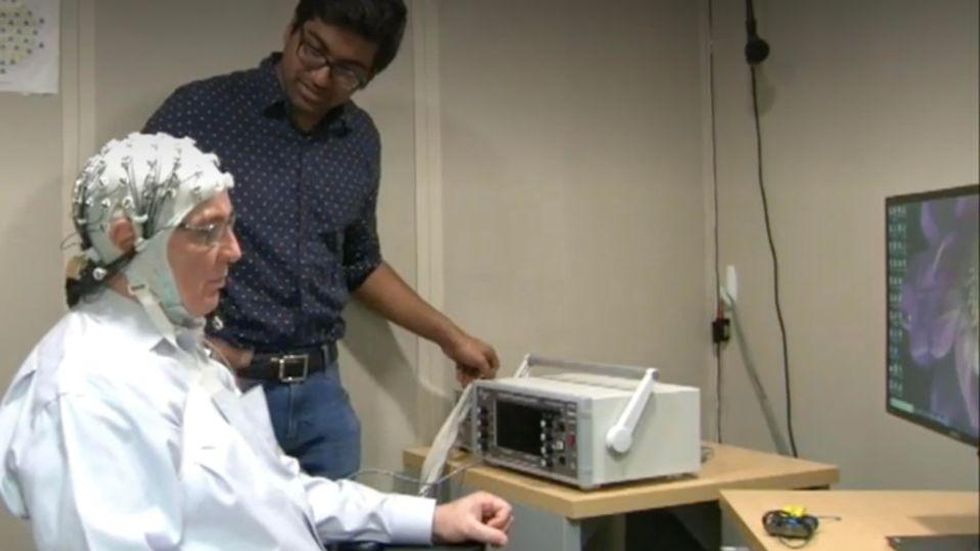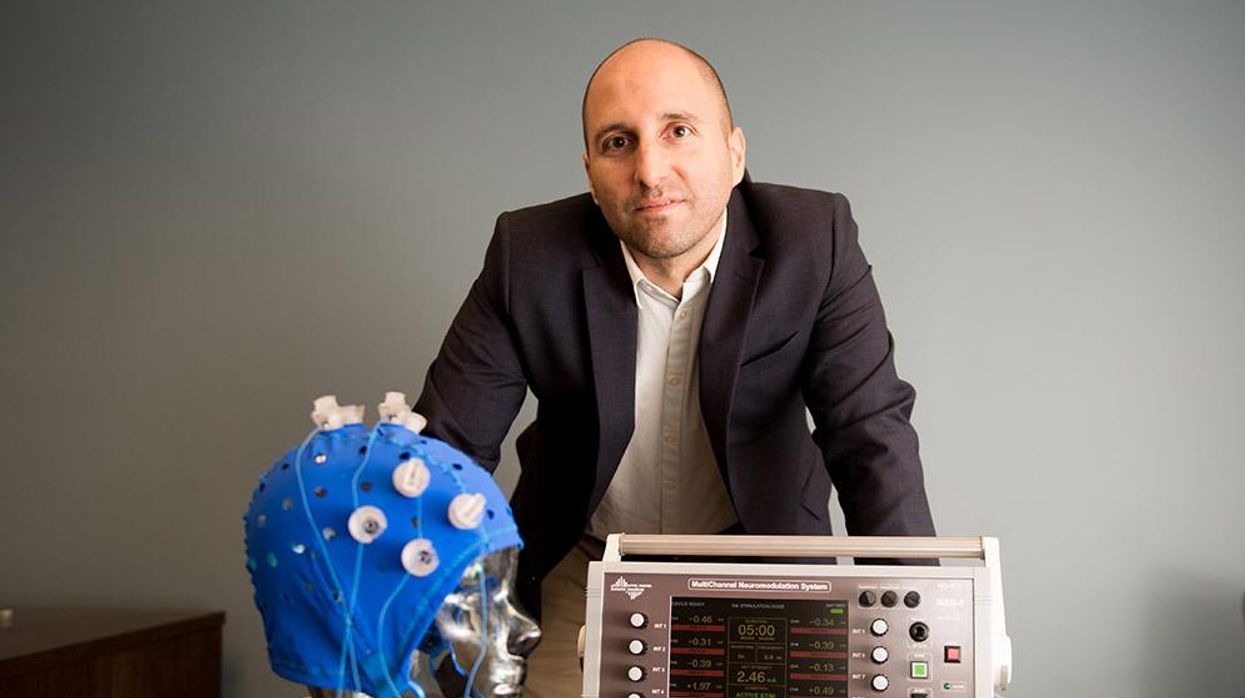China vs. the West: Who Will Lead the Way in Embryo Editing Research?

The U.S. metaphorically boxing with China over biomedical research.
Junjiu Huang and his team performed a miracle. A few miracles, actually. The researchers at Sun Yat-sen University in Guangzhou, China used the precise new DNA editing tool called CRISPR-CAS9 to edit a human embryo, replacing a single base. In doing so, they edited out beta-thalassemia, a blood disorder that reduces the production of hemoglobin, which can result in pale skin, fatigue, higher risk of blood clots, and other symptoms.
The race is on, and it's one everyone is going to try to win.
Huang's group, which did not respond to an email requesting comment for this story, injected 86 embryos and observed them for 48 hours. After that period -- a time long enough for CRISPR to split the DNA, other molecules to replace the base, and the embryos to grow to eight cells -- they tested 54 of the 71 that survived. Of those, only a few had the replacement base, according to a report of the study published in Protein & Cell. The experiment stopped there as the embryos, which had been acquired from local fertility clinics, were non-viable and not implanted.
But procreation was not the point. Far from it, in fact. The point was to demonstrate that it could be done, that in some far off (or not so far off) future, doctors could use CRISPR to eliminate diseases like Tay-Sachs, Huntington's, and cystic fibrosis that are caused by genetic mutations. Going a step further, perhaps they could eventually even tailor embryos that will develop into adults with specific traits like height and IQ.
Experts agree that we are far from that point, years if not decades away from leveraging CRISPR to cure diseases and decades if not centuries from being able to build designer babies. In that frame, Huang's achievement is just a small step, a blip on the timeline of human achievement. But seen in another light, it's yet another sign that we need to start talking about DNA modification now, establishing protocols, procedures, and plans that guide the subject before we get so far down the road that momentum is impossible to stop.
"The Chinese generally don't have the religious objections to embryo research that have held back research in the West."
It's essential to do so now because the idea of DNA modification -- a realization that humanity can control its evolution -- is compelling and attractive. Imagine a world where doctors and scientists could get rid of disease before it begins or ensure a baby would arrive with an Einstein-level IQ. That's intriguing, and also terrifying. What are the rules? How do we know when to stop? What guides the process? And how can we prevent mistakes or unwanted mutations? To borrow from another famous quotation, with great power comes great responsibility.
These aren't questions for Huang and the Chinese scientific community alone. A team from Oregon recently edited viable human embryos, eliminating a mutation that can lead to heart failure while preventing any unintended consequences. Just as importantly, every embryo they edited produced the intended genetic changes, a vital step since a partial success rate, known as mosaicism, could have devastating consequences to a future child.
In London at the Francis Crick Institute, researcher Kathy Niakan used CRISPR-CAS9 to "turn off" a gene that produces the protein OCT4. Without the protein, the fertilized egg could not produce a blastocyst, which is a key structure in early mammalian development that gives rise to an embryo and placenta. The recent study wasn't designed to go further, but the use of CRISPR was important. "One way to find out what a gene does in the developing embryo is to see what happens when it isn't working," said Dr. Niakan, who was the first scientist in the world to be granted regulatory approval to edit the genes of a human embryo for research. "Now that we have demonstrated an efficient way of doing this, we hope that other scientists will use it to find out the roles of other genes. If we knew the key genes that embryos need to develop successfully, we could improve IVF treatments and understand some causes of pregnancy failure. It may take many years to achieve such an understanding. Our study is just the first step."
The point is, CRISPR is here and it's not going anywhere. Scientists will continue to use it to learn about how humans develop. Yet different rules regarding CRISPR and embryo research in countries around the world will impact who gets there first. "I've heard the U.S.-China gene editing research parallel paths as Sputnik 2.0," said Kevin Doxzen, Science Communications Specialist at the University of California, Berkeley's Innovative Genomics Institute. The race is on, and it's one everyone is going to try to win.
Based on number of researchers and ease of regulations, the Chinese are the favorites to advance the science the furthest, the fastest.
Based on number of researchers and ease of regulations, the Chinese are the favorites to advance the science the furthest, the fastest. "The Chinese generally don't have the religious (predominantly Christian) or moral objections to embryo research that have held back research in the West," said Dr. Julian Savulescu, the Uehiro Professor of Practical Ethics and Director of the Oxford Martin Programme on Collective Responsibility for Infectious Disease at the University of Oxford. "This kind of research should be done, with the right sort of ethical oversight. The concern over China leading the way is that institutional oversight mechanisms are probably not as developed as in the West but so far, there is no evidence of breaches in standards of research ethics around the published research."
Or, put another way by bioethicist Dr. Arthur Caplan, founding director of NYU Langone Health's Division of Medical Ethics: "The Chinese, because they don't care and don't have moral reservations about embryo work, are doing what they want." This lack of aversion to working with embryos manifests itself in a couple of ways. The absence of moral qualms is one. Funding is another. Huang's study, and others like it, receive funding from the government. His, for example, was supported by two grants from the National Basic Research Program and three from the National Natural Science Foundation of China.
The U.S., on the other hand, bans any federal funding for research using human embryos. A law passed in 1996 states that federal dollars can't be used for: "research in which a human embryo or embryos are destroyed, discarded, or knowingly subjected to risk of injury or death greater than that allowed for research on fetuses." This restriction can shift incentives as many private institutions or commercial enterprises may have financial motivations or other goals beyond furthering basic research for the sake of general knowledge.
Embryo gene modification recently performed in the U.K. would merit 15 years in prison in Australia.
The embryo research ban is even more strict elsewhere. The Oviedo Convention, enacted in 1997, effectively prohibits germline engineering in members of the European Union. "In Italy, you can't destroy an embryo for any reason," said Alessandro Bertero, a postdoctoral fellow at the University of Washington's Department of Pathology who used to study in Italy. "It's illegal, and you'll go to jail." Later, Bertero was one of the researchers who worked with Dr. Niakan in London, an investigation that was allowed by the UK's Human Fertilisation and Embryology Authority. (In Australia, Niakan and her colleagues would face 15 years in jail due to the 2002 Prohibition of Human Cloning Act, which prohibits altering the genomes of embryonic cells.)
Despite the moral and legal reservations in the Western world, every person I spoke with for this story believed that better, more advanced studies and learning is happening in the U.S. and Europe. "The best studies in my opinion are from the labs in California and Oregon," Bertero said. "The quality of the work [in the Chinese study] – not being critical, but to be scientifically critical -- was just quick and dirty. It was, 'Let's just show that we have done it and get it out.' That doesn't mean that the quality of the work was good."
"If the Chinese or someone else starts beating our brains out, we're not going to want to stand by idly and not do these things."
How long that remains the case, however, is an open question. A significant number of groups in China are working on germline editing in human embryos. The concern is that the Chinese will emerge as a leader sooner rather than later because they can do research with embryos more easily than their Western counterparts.
For Caplan, the NYU professor, the embryo ban in the U.S. isn't based on science; it's rooted in something else. "It's 96 percent political," he said, laughing. "It has basically ground to a halt because no one wants to see repercussions take place if federal funding is involved. The NIH isn't involved. And they won't be."
What, in his mind, would get Americans to start realizing the benefits that embryo research would provide? "The perception that other countries were moving quickly to get the advantages of CRISPR and other gene modification techniques, finding more industrial and more medical purposes," he said. "If the Chinese or someone else starts beating our brains out, we're not going to want to stand by idly and not do these things."
Doing so would involve difficult conversations about the role of embryos in research. But these are philosophical questions that need to be approached at some point. From a U.S. perspective, doing so sooner while the American scientists still hold the technological and informational edge, is vital. Ignoring the issue doesn't make it go away.
Experts think a few changes should be made. The ban on federal funding should be lifted. Scientists and regulators should push for things like allowing federal funds to be used for the creation of new embryos for research purposes and the use of spare IVF embryos for research when the embryo would not be implanted into a woman. (Privately funded scientists can proceed in states that encourage embryonic stem cell research, like New York, New Jersey, and California, but not in restrictive ones like Louisiana and South Dakota, which prohibit creating or destroying embryos for research.) Policymakers could ban reproductive gene editing for now but look at it again after a certain period. A highly anticipated report issued earlier this year from an international guidance committee left the door open to eventual clinical trials with edited embryos. As of now, however, Congress will not allow the Food and Drug Administration to consider such trials. This is the future and it's the scientific community's responsibility to develop the ethical framework now.
"The US and Europe have the technological history and capacity to lead this research and should do so, ethically. We ought to be revising our laws and ethical guidelines to facilitate this kind of research," Professor Savulescu said. "But the challenge is to think constructively and ethically about this new technology, and to be leaders, not followers."
The Friday Five: How to exercise for cancer prevention
How to exercise for cancer prevention. Plus, a device that brings relief to back pain, ingredients for reducing Alzheimer's risk, the world's oldest disease could make you young again, and more.
The Friday Five covers five stories in research that you may have missed this week. There are plenty of controversies and troubling ethical issues in science – and we get into many of them in our online magazine – but this news roundup focuses on scientific creativity and progress to give you a therapeutic dose of inspiration headed into the weekend.
Listen on Apple | Listen on Spotify | Listen on Stitcher | Listen on Amazon | Listen on Google
Here are the promising studies covered in this week's Friday Five:
- How to exercise for cancer prevention
- A device that brings relief to back pain
- Ingredients for reducing Alzheimer's risk
- Is the world's oldest disease the fountain of youth?
- Scared of crossing bridges? Your phone can help
New approach to brain health is sparking memories
This fall, Robert Reinhart of Boston University published a study finding that electrical stimulation can boost memory - and Reinhart was surprised to discover the effects lasted a full month.
What if a few painless electrical zaps to your brain could help you recall names, perform better on Wordle or even ward off dementia?
This is where neuroscientists are going in efforts to stave off age-related memory loss as well as Alzheimer’s disease. Medications have shown limited effectiveness in reversing or managing loss of brain function so far. But new studies suggest that firing up an aging neural network with electrical or magnetic current might keep brains spry as we age.
Welcome to non-invasive brain stimulation (NIBS). No surgery or anesthesia is required. One day, a jolt in the morning with your own battery-operated kit could replace your wake-up coffee.
Scientists believe brain circuits tend to uncouple as we age. Since brain neurons communicate by exchanging electrical impulses with each other, the breakdown of these links and associations could be what causes the “senior moment”—when you can’t remember the name of the movie you just watched.
In 2019, Boston University researchers led by Robert Reinhart, director of the Cognitive and Clinical Neuroscience Laboratory, showed that memory loss in healthy older adults is likely caused by these disconnected brain networks. When Reinhart and his team stimulated two key areas of the brain with mild electrical current, they were able to bring the brains of older adult subjects back into sync — enough so that their ability to remember small differences between two images matched that of much younger subjects for at least 50 minutes after the testing stopped.
Reinhart wowed the neuroscience community once again this fall. His newer study in Nature Neuroscience presented 150 healthy participants, ages 65 to 88, who were able to recall more words on a given list after 20 minutes of low-intensity electrical stimulation sessions over four consecutive days. This amounted to a 50 to 65 percent boost in their recall.
Even Reinhart was surprised to discover the enhanced performance of his subjects lasted a full month when they were tested again later. Those who benefited most were the participants who were the most forgetful at the start.

An older person participates in Robert Reinhart's research on brain stimulation.
Robert Reinhart
Reinhart’s subjects only suffered normal age-related memory deficits, but NIBS has great potential to help people with cognitive impairment and dementia, too, says Krista Lanctôt, the Bernick Chair of Geriatric Psychopharmacology at Sunnybrook Health Sciences Center in Toronto. Plus, “it is remarkably safe,” she says.
Lanctôt was the senior author on a meta-analysis of brain stimulation studies published last year on people with mild cognitive impairment or later stages of Alzheimer’s disease. The review concluded that magnetic stimulation to the brain significantly improved the research participants’ neuropsychiatric symptoms, such as apathy and depression. The stimulation also enhanced global cognition, which includes memory, attention, executive function and more.
This is the frontier of neuroscience.
The two main forms of NIBS – and many questions surrounding them
There are two types of NIBS. They differ based on whether electrical or magnetic stimulation is used to create the electric field, the type of device that delivers the electrical current and the strength of the current.
Transcranial Current Brain Stimulation (tES) is an umbrella term for a group of techniques using low-wattage electrical currents to manipulate activity in the brain. The current is delivered to the scalp or forehead via electrodes attached to a nylon elastic cap or rubber headband.
Variations include how the current is delivered—in an alternating pattern or in a constant, direct mode, for instance. Tweaking frequency, potency or target brain area can produce different effects as well. Reinhart’s 2022 study demonstrated that low or high frequencies and alternating currents were uniquely tied to either short-term or long-term memory improvements.
Sessions may be 20 minutes per day over the course of several days or two weeks. “[The subject] may feel a tingling, warming, poking or itching sensation,” says Reinhart, which typically goes away within a minute.
The other main approach to NIBS is Transcranial Magnetic Simulation (TMS). It involves the use of an electromagnetic coil that is held or placed against the forehead or scalp to activate nerve cells in the brain through short pulses. The stimulation is stronger than tES but similar to a magnetic resonance imaging (MRI) scan.
The subject may feel a slight knocking or tapping on the head during a 20-to-60-minute session. Scalp discomfort and headaches are reported by some; in very rare cases, a seizure can occur.
No head-to-head trials have been conducted yet to evaluate the differences and effectiveness between electrical and magnetic current stimulation, notes Lanctôt, who is also a professor of psychiatry and pharmacology at the University of Toronto. Although TMS was approved by the FDA in 2008 to treat major depression, both techniques are considered experimental for the purpose of cognitive enhancement.
“One attractive feature of tES is that it’s inexpensive—one-fifth the price of magnetic stimulation,” Reinhart notes.
Don’t confuse either of these procedures with the horrors of electroconvulsive therapy (ECT) in the 1950s and ‘60s. ECT is a more powerful, riskier procedure used only as a last resort in treating severe mental illness today.
Clinical studies on NIBS remain scarce. Standardized parameters and measures for testing have not been developed. The high heterogeneity among the many existing small NIBS studies makes it difficult to draw general conclusions. Few of the studies have been replicated and inconsistencies abound.
Scientists are still lacking so much fundamental knowledge about the brain and how it works, says Reinhart. “We don’t know how information is represented in the brain or how it’s carried forward in time. It’s more complex than physics.”
Lanctôt’s meta-analysis showed improvements in global cognition from delivering the magnetic form of the stimulation to people with Alzheimer’s, and this finding was replicated inan analysis in the Journal of Prevention of Alzheimer’s Disease this fall. Neither meta-analysis found clear evidence that applying the electrical currents, was helpful for Alzheimer’s subjects, but Lanctôt suggests this might be merely because the sample size for tES was smaller compared to the groups that received TMS.
At the same time, London neuroscientist Marco Sandrini, senior lecturer in psychology at the University of Roehampton, critically reviewed a series of studies on the effects of tES on episodic memory. Often declining with age, episodic memory relates to recalling a person’s own experiences from the past. Sandrini’s review concluded that delivering tES to the prefrontal or temporoparietal cortices of the brain might enhance episodic memory in older adults with Alzheimer’s disease and amnesiac mild cognitive impairment (the predementia phase of Alzheimer’s when people start to have symptoms).
Researchers readily tick off studies needed to explore, clarify and validate existing NIBS data. What is the optimal stimulus session frequency, spacing and duration? How intense should the stimulus be and where should it be targeted for what effect? How might genetics or degree of brain impairment affect responsiveness? Would adjunct medication or cognitive training boost positive results? Could administering the stimulus while someone sleeps expedite memory consolidation?
Using MRI or another brain scan along with computational modeling of the current flow, a clinician could create a treatment that is customized to each person’s brain.
While Sandrini’s review reported improvements induced by tES in the recall or recognition of words and images, there is no evidence it will translate into improvements in daily activities. This is another question that will require more research and testing, Sandrini notes.
Scientists are still lacking so much fundamental knowledge about the brain and how it works, says Reinhart. “We don’t know how information is represented in the brain or how it’s carried forward in time. It’s more complex than physics.”
Where the science is headed
Learning how to apply precision medicine to NIBS is the next focus in advancing this technology, says Shankar Tumati, a post-doctoral fellow working with Lanctôt.
There is great variability in each person’s brain anatomy—the thickness of the skull, the brain’s unique folds, the amount of cerebrospinal fluid. All of these structural differences impact how electrical or magnetic stimulation is distributed in the brain and ultimately the effects.
Using MRI or another brain scan along with computational modeling of the current flow, a clinician could create a treatment that is customized to each person’s brain, from where to put the electrodes to determining the exact dose and duration of stimulation needed to achieve lasting results, Sandrini says.
Above all, most neuroscientists say that largescale research studies over long periods of time are necessary to confirm the safety and durability of this therapy for the purpose of boosting memory. Short of that, there can be no FDA approval or medical regulation for this clinical use.
Lanctôt urges people to seek out clinical NIBS trials in their area if they want to see the science advance. “That is how we’ll find the answers,” she says, predicting it will be 5 to 10 years to develop each additional clinical application of NIBS. Ultimately, she predicts that reigning in Alzheimer’s disease and mild cognitive impairment will require a multi-pronged approach that includes lifestyle and medications, too.
Sandrini believes that scientific efforts should focus on preventing or delaying Alzheimer’s. “We need to start intervention earlier—as soon as people start to complain about forgetting things,” he says. “Changes in the brain start 10 years before [there is a problem]. Once Alzheimer’s develops, it is too late.”

